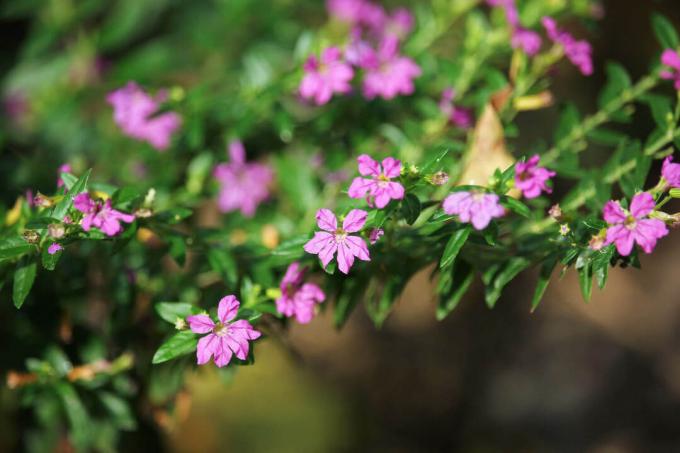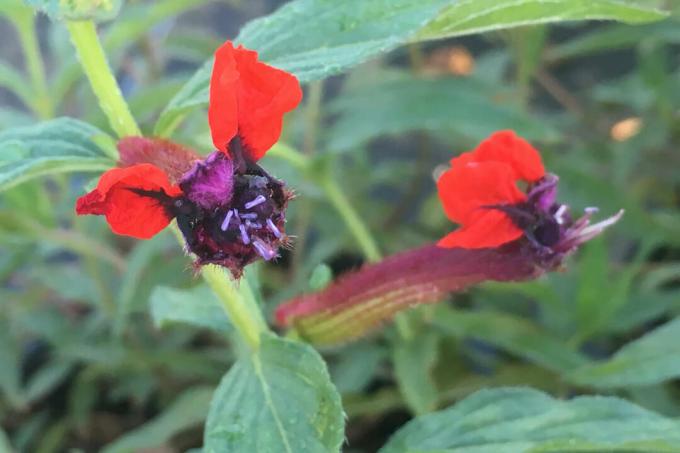The variety of quiver flowers is impressive and it impresses with a unique flower. The subtropical species even thrive in our gardens.

The best-known quiver flower is probably the Japanese pseudo myrtle, but the cigarette flower and the bat face are also very popular. The unusual name also includes special flowers. We introduce the species and show how to plant and care for them.
contents
- Cuphea: characteristics and origin
- The most beautiful species and varieties
- Planting Cuphea: location and procedure
- Care of the Cuphea
- Multiplication
- Is the quiver flower hardy?
- Is the Cuphea poisonous?
Cuphea: characteristics and origin
With the quiver flowers (Cuphea) is a genus of plants that includes around 250 different species. They belong to the loosestrife family (Lythraceae) and occur naturally in South and Central America. The tropical and subtropical plants grow herbaceous, as climbing plants or as subshrubs. Some species can also be kept in the garden or in pots at our latitude. In contrast to their tropical home, many only stay one year at our low winter temperatures. When kept in pots and with a species-appropriate wintering, most quiver flowers can even grow here for several years. Most quiver flowers bloom in summer. Each species develops individual, decorative flowers that not only please us humans.

Is the quiver flower friendly to bees? Here, too, quiver flowers are bee-friendly and attract a wide variety of insects with their nectar and eye-catching flowers.
The most beautiful species and varieties
Some of the numerous Cuphea-Species can also be kept as garden or houseplant with us. We introduce the most popular. There are in turn different varieties of each species, which usually differ in the color of the flowers.
- Cuphea ignea: The so-called cigarette quiver flower forms elongated, tubular and bright red flowers that are reminiscent of smoldering cigarettes. It is actually a perennial shrub which, due to its sensitivity to frost, usually only grows annually in Germany.

- Cuphea hyssopifolia: The Japanese false myrtle or false heather looks very different from its relatives Cuphea ignea. Depending on the variety, the small, radially symmetrical flowers can have different colors such as purple or pink.
- Cuphea hyssopifolia "Floryglory Premium Limelight": The newly emerging leaves are initially light green on the variety. They will turn darker over time.
- Cuphea hyssopifolia "Allyson Lavender": This strain can be used perfectly as a ground cover as it grows flat.

- Cuphea llavea: This species has particularly unusual flowers, which in many varieties are somewhat reminiscent of the head of a bat. It is therefore also called the bat face. It can be kept both in the apartment and in the garden, where bees like to visit it. Provided that it can be overwintered in a warm place, this quiver flower is also perennial.
- Cuphea llavea ‘Sriracha Rose’: Although they are also part of Art Cuphea llavea heard, the flowers of this variety do not look like bats, but are round, but no less noticeable.

Planting Cuphea: location and procedure
With a genre as extensive as that Cuphea you should always consider the species-specific requirements when it comes to location and maintenance. However, there are some location factors that are common to most Cuphea-Types are suitable.
Quiver flowers prefer a bright location without direct sunlight at lunchtime. The soil should be fresh, loose and nutritious. Since these flowers are not hardy, they can be planted in a tub, balcony box or pot. This can be placed in a warmer place in winter, so that the quiver flowers will bloom again next year. In addition, the substrate is warmed through faster in the pot, which the Cuphea benefits. The planter should have a drainage hole for the irrigation water. A layer of pebbles or expanded clay can be placed on the bottom of the pot to make it easier to drain. Now use a high-quality soil, such as ours Plantura organic potting soil. It consists of natural raw materials, contains many nutrients and remains structurally stable for a long time. If you would prefer to plant the quiver flower in the garden, you can also mix potting soil into the planting hole to improve the conditions for the Cuphea to improve. In the bed, for example, you can see fan-like growing varieties such as Cuphea hyssopifolia ‘Alysson Lavender’ looks particularly beautiful. With twelve plants per square meter, the ground cover is achieved quickly.
Tip: Cuphea actually thrives in drier soils, but unfortunately the flowering is not quite as abundant.
Finally, it is advisable to cover the substrate with a layer of mulch, for example from ours Plantura organic pine barkto cover. The pine bark looks decorative and ensures that water evaporation from the earth is reduced.
Note: The quiver flower can be kept in the apartment all year round as a houseplant or, depending on the weather, placed in a pot on the balcony or in the garden.
Care of the Cuphea
In addition to regular watering, quiver flower care also requires a supply of nutrients via fertilizers so that the Cuphea-Plants develop beautiful flowers.
Quiver flowers should be watered regularly with lime-free water. Plants in pots are always watered when the substrate surface is dry. Excess liquid that collects in the coaster is poured off. Quiver flowers in the bed should also be watered as soon as the soil is dry. This can be checked with the help of the finger test. If it rains frequently, there is no need to water.

Quiver flowers need a lot of nutrients to grow well and produce numerous flowers. A slow release fertilizer such as ours is recommended for bedding plants Plantura organic universal fertilizer. You can simply sprinkle it on the ground in April or May and work it in. The soil is then watered and the nutrients are slowly released to the plant over a period of at least three months. Our fertilizer is completely harmless for garden animals and consists of natural ingredients.
For quiver flowers in the winter garden or on the balcony, on the other hand, a liquid fertilizer is more suitable, which is regularly added to the irrigation water. A high-quality liquid fertilizer is ours, for example Plantura organic flower & balcony fertilizerwhich was specially developed for flowering plants such as the cuttlefish. It ensures abundant flowering and strong roots.
Our liquid flowering plant fertilizer is fertilized with half the dose once a week from spring to autumn. House plants that are kept under the same conditions in winter can be fertilized every two months from autumn to spring and watered occasionally.

Cutting back does most of them Cuphea-Types good. With annual shrubs, the withered inflorescences can be cut off. There is then a chance of a renewed bloom. In order to promote compact and bushy growth, the tips of the shoots should be cut off. Perennial shrubs should be shortened by about a third in the spring with a rejuvenation cut. They then sprout again and form many flowers. In winter the pseudo myrtle can freeze back a lot, but will sprout again afterwards. It is best to protect the base with a thick layer of mulch.
Tip: Quiver flowers in pots should be repotted in fresh substrate every spring.
Multiplication
The easiest way to propagate a quiver flower is by cuttings. To do this, cut a few head cuttings about 5 cm long at an angle from the mother plant in spring or autumn. The shoots should not have any flowers and should not be completely woody. The bottom leaves are removed. Then the cuttings are placed in growth substrate and watered. A plastic bag can be put over the vessel. Put the pots in a bright and warm place. As soon as new leaves emerge, it is time to plant the young plants in more nutrient-rich soil.

Is the quiver flower hardy?
Not all quiver flowers are hardy. While Cuphea llavea and Cuphea hyssopifolia Tolerate temperatures down to about - 10 ° C, may Cuphea ignea only temperatures above freezing. It should therefore be overwintered in the house. There is now less watering, fertilizing only every two months. Bedding plants that are more frost-tolerant should be covered with a layer of mulch.
Is the Cuphea poisonous?
Quiver flowers are considered non-toxic to both humans and pets. However, the parts of ornamental plants should not be consumed.
If you can't get enough of extraordinary flowers, you should take a look at the Crown of fame throw. You can find out everything about planting, caring for and wintering with us.
